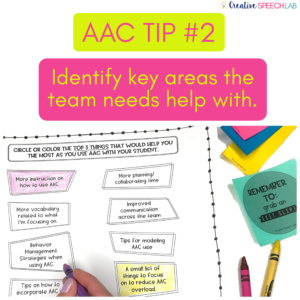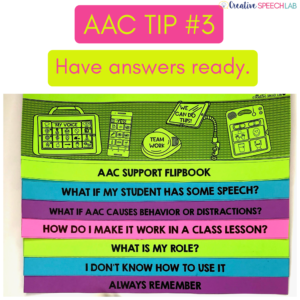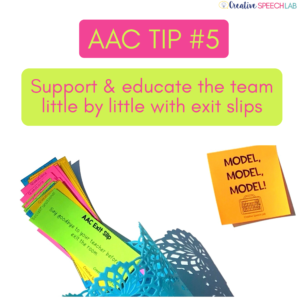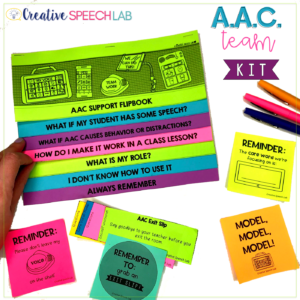As an SLP, I’d like to share what I believe to be the best kept secret for successful AAC implementation.
It takes leadership. Plain and simple.
Or maybe not so plain and simple…
Since I tend to be a planner (anyone else?), I’ve learned there’s a way to work smarter (and not necessarily harder) when it comes to making a real impact here.
Today I’m sharing my top 6 tips for AAC implementation, which I’ve found to be much more lasting and successful when the team is well coordinated!
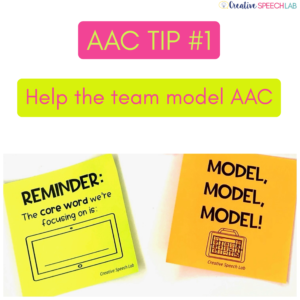
1. Help the team model AAC
We all know how important modeling is in virtually every aspect of speech-language therapy, and this is of particular importance when implementing AAC.
Most of the time our students are with their SLP for only a portion of their week, so it is immensely valuable to encourage the team to provide models for the student throughout their day. Not only will it help to present more examples of communicating with AAC, it’s also valuable to see different people using it to communicate.
I like to use AAC sticky notes, which can travel with students, and serve as a simple reminder. I also have fill-in-the-blank notes so that the team can work on modeling the same core vocabulary word each week in different contexts!
2. Identify key areas the team needs help with.
It’s SO important to not skip over this part. In order for everyone on the team to be do the work needed for students, it’s important to give them the support they need.
After speaking with different team members over the years, I was able to compile a list (pictured above) of common AAC implementation challenges. This has helped tremendously to know how best to support them.
3. Have answers ready.
AAC implementation often leads to a lot of questions…
When those questions remain unanswered, despite good intentions, that can sometimes contribute to AAC abandonment and/or a lack of modeling.
So, I suggest that we hit the ground running, armed with answers to the most frequently asked questions related to AAC implementation.
I created this AAC Support Flipbook to proactively address common questions and concerns for the team in a way that reduces overwhelm and inspires interest!
4. Make it EASY to keep the team on the same page while collecting data.
Data collection doesn’t have to be complicated. Promoting a team focus with simple accountability measures can actually bring the team together.
I created a simple AAC access team checklist for students to carry with their communication aids. This list helps the team work together in a simple, straightforward and methodical way (even if the team doesn’t see each other very frequently during the day!)
5. Support & educate the team, little by little, with exit slips.
If you’ve spent time here on my blog or on social media, you know that I love using exit slips in speech-language therapy. This simple routine is supported by research, and offers an easy yet powerful way to help reinforce important concepts to students at the end of each session.
I believe that all students should have the opportunity to benefit from exit slips, which is why I created a special set of AAC exit slips to make an added impact each day.
6. Use visuals to reduce AAC abandonment.
Despite the team’s best intentions, AAC abandonment can sometimes become a sad reality when AAC implementation becomes too challenging. One insight I’ve developed over the years has been the importance of referring to a student’s communication aid as a “talker” or a “voice,” particularly if it’s a communication app on an undedicated tablet.
In an effort to advocate for students, I wrote a poem entitled “Please Don’t Leave My Voice on the Shelf.” You can find a free download of the poem, related visuals, and a powerful video on my AAC Advocacy webpage.
If any of the specific ideas or tools I shared above would help you and your team to successfully implement AAC, check out my AAC Team Kit. I hope it helps if you try it!
I hope this post has helped you to feel focused, supported and inspired to successfully implement AAC with your students!
Thank you for helping your students find and share their beautiful voices with the world.


